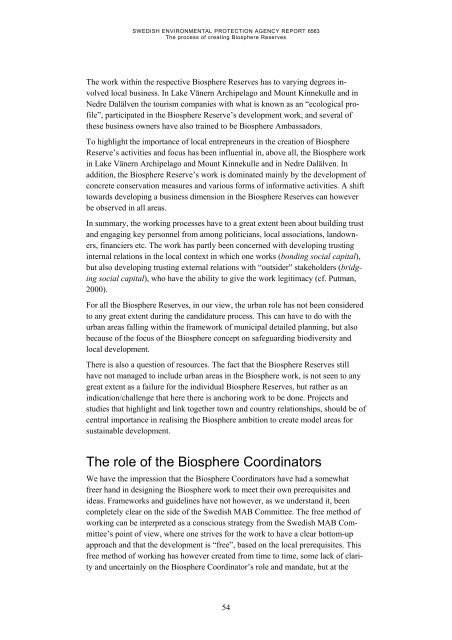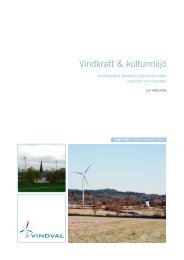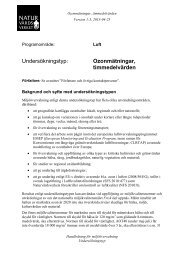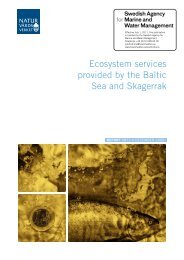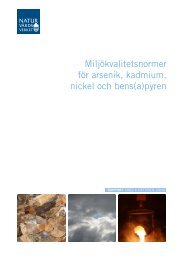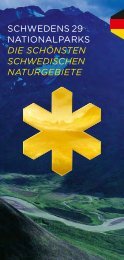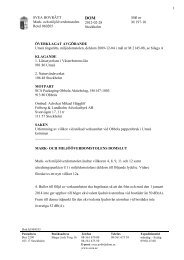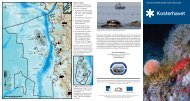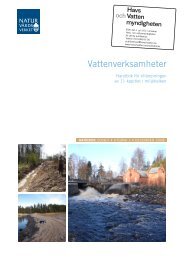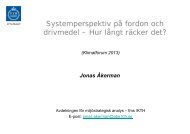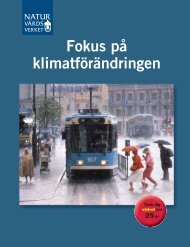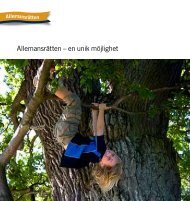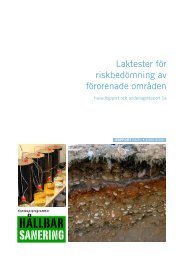The process of creating Biosphere Reserves- An ... - Naturvårdsverket
The process of creating Biosphere Reserves- An ... - Naturvårdsverket
The process of creating Biosphere Reserves- An ... - Naturvårdsverket
Create successful ePaper yourself
Turn your PDF publications into a flip-book with our unique Google optimized e-Paper software.
SWEDISH ENVIRONMENTAL PROTECTION AGENCY REPORT 6563<br />
<strong>The</strong> <strong>process</strong> <strong>of</strong> <strong>creating</strong> <strong>Biosphere</strong> <strong>Reserves</strong><br />
<strong>The</strong> work within the respective <strong>Biosphere</strong> <strong>Reserves</strong> has to varying degrees involved<br />
local business. In Lake Vänern Archipelago and Mount Kinnekulle and in<br />
Nedre Dalälven the tourism companies with what is known as an “ecological pr<strong>of</strong>ile”,<br />
participated in the <strong>Biosphere</strong> Reserve’s development work, and several <strong>of</strong><br />
these business owners have also trained to be <strong>Biosphere</strong> Ambassadors.<br />
To highlight the importance <strong>of</strong> local entrepreneurs in the creation <strong>of</strong> <strong>Biosphere</strong><br />
Reserve’s activities and focus has been influential in, above all, the <strong>Biosphere</strong> work<br />
in Lake Vänern Archipelago and Mount Kinnekulle and in Nedre Dalälven. In<br />
addition, the <strong>Biosphere</strong> Reserve’s work is dominated mainly by the development <strong>of</strong><br />
concrete conservation measures and various forms <strong>of</strong> informative activities. A shift<br />
towards developing a business dimension in the <strong>Biosphere</strong> <strong>Reserves</strong> can however<br />
be observed in all areas.<br />
In summary, the working <strong>process</strong>es have to a great extent been about building trust<br />
and engaging key personnel from among politicians, local associations, landowners,<br />
financiers etc. <strong>The</strong> work has partly been concerned with developing trusting<br />
internal relations in the local context in which one works (bonding social capital),<br />
but also developing trusting external relations with “outsider” stakeholders (bridging<br />
social capital), who have the ability to give the work legitimacy (cf. Putman,<br />
2000).<br />
For all the <strong>Biosphere</strong> <strong>Reserves</strong>, in our view, the urban role has not been considered<br />
to any great extent during the candidature <strong>process</strong>. This can have to do with the<br />
urban areas falling within the framework <strong>of</strong> municipal detailed planning, but also<br />
because <strong>of</strong> the focus <strong>of</strong> the <strong>Biosphere</strong> concept on safeguarding biodiversity and<br />
local development.<br />
<strong>The</strong>re is also a question <strong>of</strong> resources. <strong>The</strong> fact that the <strong>Biosphere</strong> <strong>Reserves</strong> still<br />
have not managed to include urban areas in the <strong>Biosphere</strong> work, is not seen to any<br />
great extent as a failure for the individual <strong>Biosphere</strong> <strong>Reserves</strong>, but rather as an<br />
indication/challenge that here there is anchoring work to be done. Projects and<br />
studies that highlight and link together town and country relationships, should be <strong>of</strong><br />
central importance in realising the <strong>Biosphere</strong> ambition to create model areas for<br />
sustainable development.<br />
<strong>The</strong> role <strong>of</strong> the <strong>Biosphere</strong> Coordinators<br />
We have the impression that the <strong>Biosphere</strong> Coordinators have had a somewhat<br />
freer hand in designing the <strong>Biosphere</strong> work to meet their own prerequisites and<br />
ideas. Frameworks and guidelines have not however, as we understand it, been<br />
completely clear on the side <strong>of</strong> the Swedish MAB Committee. <strong>The</strong> free method <strong>of</strong><br />
working can be interpreted as a conscious strategy from the Swedish MAB Committee’s<br />
point <strong>of</strong> view, where one strives for the work to have a clear bottom-up<br />
approach and that the development is “free”, based on the local prerequisites. This<br />
free method <strong>of</strong> working has however created from time to time, some lack <strong>of</strong> clarity<br />
and uncertainly on the <strong>Biosphere</strong> Coordinator’s role and mandate, but at the<br />
54


